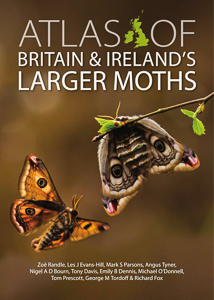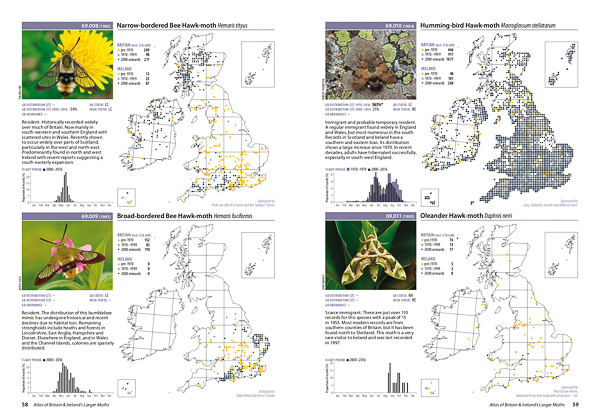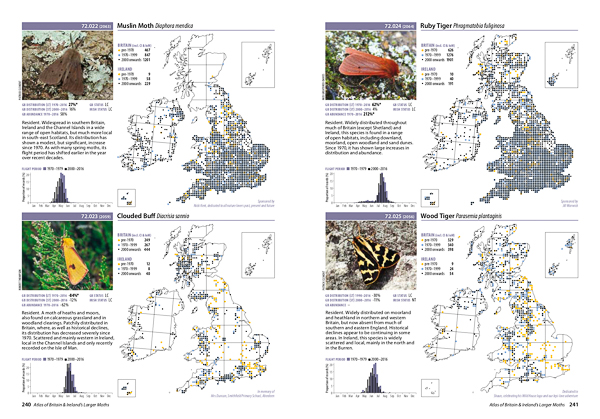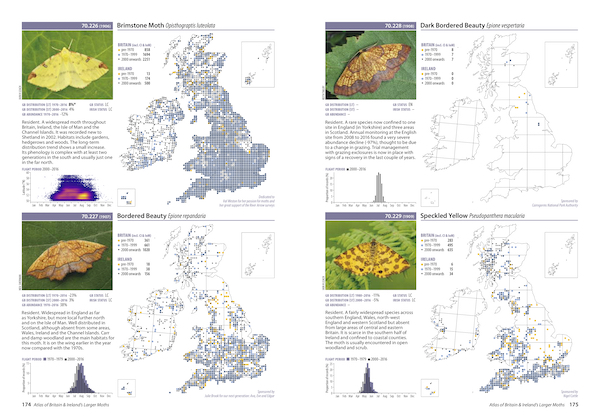 |
Around 25 million moth records from Butterfly Conservation's National Moth Recording Scheme and Moths Ireland have been combined to produce this landmark publication - the first ever atlas of all macro-moths in Britain, Ireland, the Isle of Man and the Channel Islands. The atlas includes accounts for 866 macro-moth species, each with a distribution map showing current and historical occurrences, trends, status, a phenology chart and colour image. A further 25 species, which were former residents, but have not been recorded from 1970 onwards, have a distribution map. Brief introductory chapters detail the long-standing tradition of moth recording and the development of the National Moth Recording Scheme, methods used to collect and analyse the data, an overview of trends since the 1970s and the environmental drivers of change in moth populations and distributions.
As a self-confessed 'butterfly nut' that has yet to defect to the 'dark side', I must admit that I felt that a book whose title includes the words 'moth' and 'atlas' would leave me cold. How wrong I was, and shame on me, for this is an astonishing piece of work that I've hardly put down since receiving a copy, busy absorbing information on those species found on my local patch. It's also made me realise that I should pay more attention when I visit interesting butterfly localities on my travels, such as the Burren in Ireland or the area around Morecambe Bay.
The first thing to hit you with this latest work is its sheer weight, for this is a book of substance, covering 893 species of the larger (macro) moths - the result of a collaboration between Butterfly Conservation (and its associated National Moth Recording Scheme) and MothsIreland. With records spanning 1741 to 2016, Britain, Ireland, the Isle of Man and the Channel Islands are all mapped, and this is the first work to include the distribution of all the macro-moths. With a foreword by Sir David Attenborough, the book is rightly "Dedicated to the thousands of moth recorders who made it all possible" and, putting their contribution into context, this equates to an incredible 275 years of survey effort and 25,642,265 records.
 |
While the focus of the book is clearly on the distribution of the species covered, the front sections make for some interesting reading and start with a justification for such a publication: "Given the current global concern about insect decline and potential implications for human wellbeing, it is vital to understand what is happening to our insect populations, to highlight these changes and use this understanding to attempt to address the various and intertwined threats they face". The introduction also includes "Both this atlas and the recording scheme datasets on which it is based make important contributions to moth conservation" (through informed site management, land-use change and development, and landscape-scale conservation). Reassuringly, such a bold claim is not only backed up by the phenomenal recording effort, but also by the rigorous process by which records are validated, which is also described.
In addition to a variety of useful summary charts, the front sections also go into the causes of increases and declines, and conservation. There is a thoughtful roundup of challenges facing our moth fauna, including a brief discussion on land use, climate change, pesticides and light pollution. Environmental pollution is also discussed, such as nutrient enrichment arising due to increased nitrogen levels in rain, soils and water bodies, which alters the plant communities, with a corresponding knock-on effect (positive and negative) on our moths, and a further effect on the bats and birds that feed upon them (or their immature stages).
 |
Of course, the vast majority of the book is focused on the species accounts and, especially, the species distributions (this is an atlas, after all). Scientific and vernacular names follow the Checklist of Lepidoptera of the British Isles, including revisions of that work since it was first published. Each species description includes status, distribution and abundance trends over time and a brief species account (with an associated high-quality photo). There are, however, two elements that I found particularly interesting. The first is that the flight periods of different species are not only shown using a phenology chart that many readers will be familiar with but also, on occasion, a phenogram that also allows latitude to be shown, indicating differences in flight period between north and south. The second is that the number of 10km squares recorded in different time periods is also shown, which provides a clear indication of the growing popularity of moth recording.
 |
It would be no exaggeration to say that, if I were to be tipped over the edge and into the world of 'mothing', then this is one of those publications that I'd consider essential - which is just how I viewed The Millennium Atlas of Butterflies in Britain and Ireland back in 2001. The latter is considered one of the classic works related to our Lepidoptera. 'Atlas of Britain & Ireland's Larger Moths' will surely join these ranks.